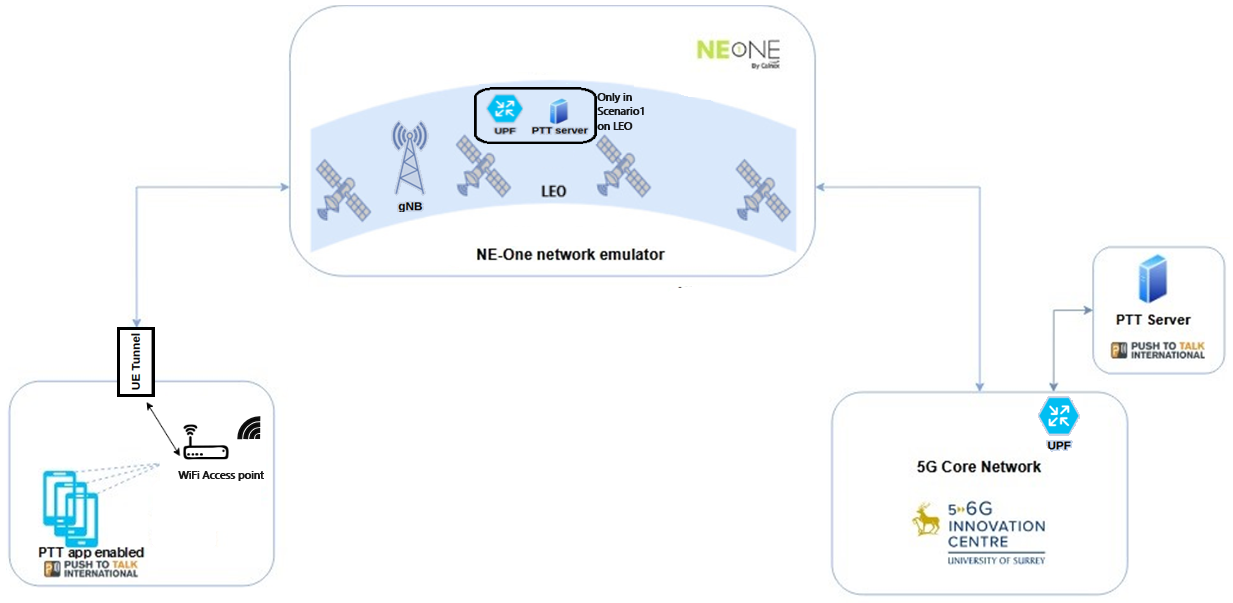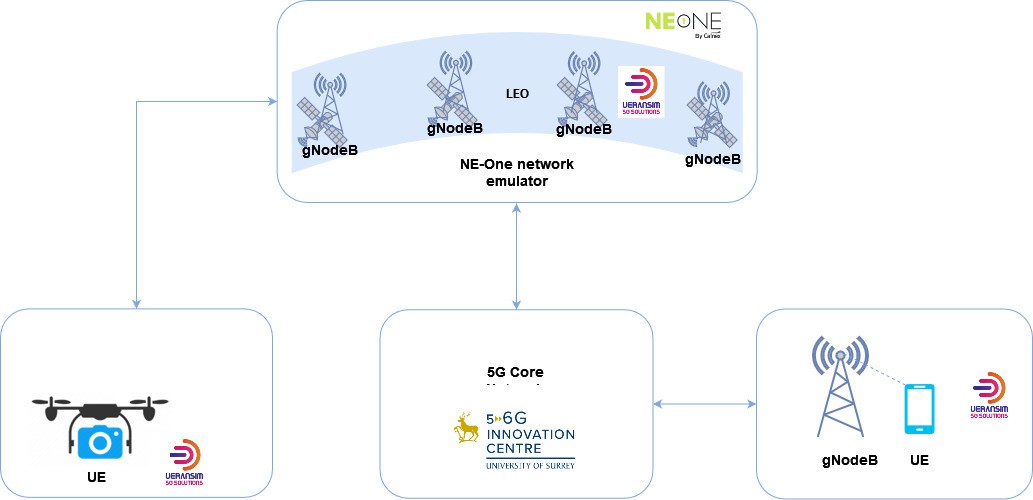-
StatusCompleted
-
Status date2025-10-14
-
Activity Code3A.120
Enable 5G satellites nodes by extending terrestrial 5G network functions, protocols and Software-Defined Networking (SDN)/Multi-access Edge Computing (MEC)/edge computing and storage and distributed control and management concepts to space.
Develop mechanisms to address the secure instantiation, control and management of the network functions on 5G satellite nodes in order to enable optimised connectivity, coverage and capacity allocations.
Develop a testbed to demonstrate an end-to-end network with integrated 5G non-terrestrial networks (NTN) nodes.
Identify, describe and analyse:
- Scenarios of 3D NTN satellite network architectures and their services;
- Context aware and advanced routing protocols;
- Hardware and software solutions for software-defined reprogrammable satellite payloads;
- Hardware and software solutions of onboard edge computing;
- Enhancements of Software Defined Networking control and management and data plane forwarding functions.
The activity shall design and specify a System Minimum Viable Product (MVP) and implement a representative 3D NTN testbed to validate and analyse the performance of the MVP. The testbed could also be interconnected with 5G integrated satellite terrestrial test platform to assess the performance of end-to-end services and show case representative use cases.
The activity will propose development roadmap for the identified critical technology elements as well as technology demonstration missions.
The two main challenges that are the focus of this project are:
- Constraints on the 5G node types that can be fitted to NTN payloads, or are worthwhile fitting to payloads, and their performance and capacity as a result of the payload constraints on mass and power;
- Network aspects due to the scale, layout and movement in the topology, such as deployment and configurations of distributed functions over the global system, handover management, and end-to-end service slice management.
The targeted improvement is enabling technical assessment and validation of solutions for 5G satellite nodes to implement flexible NTN systems.
A testbed has been produced in the project, consisting of a hybrid of real components and emulated components as follows:
- A commercial network emulator (Calnex NE-One), upon which we have developed a 3D-NTN capability (GEO and non-GEO, UAV) and links between them with channel models to emulate capacity, latency and packet loss;
- Control and User Plane Separation where typically the control plane is over GEO satellite and user plane over non-GEO,
- Fully virtualised 3GPP compliant 5G core network (real, not emulated), where the virtualised functions can be run on machines that are embedded in the network emulator;
- An Open-source RAN emulator (UERANSIM) with separate gNB and UE virtualised functions (does not include the PHY layer), that can also be run on machines that are embedded in the network emulator;
- A Push to Talk Application, provided by Tassta, fully integrated in the testbed to demonstrate the deployment of commercial voice application server on satellite payload;
- Use-cases mounted on the testbed, which are (a) Emergency Services, that utilised embedded PTT server and UPF embedded into NTN nodes, (b) Broadband to moving platform that separates non-real-time traffic from real-time traffic and transports the non-real-time over gNB on a GEO and real-time over gNB on LEO, and (c) Event Support that utilises a UAV that can carry a gNB or a UE (with gNB on LEO satellite).
The TINA project has achieved its objectives, and the outputs are complete.
Looking further ahead towards 6G where full open networking will be extended to the Core as well as the RAN the ability in the TINA emulator to bind network functions to nodes throughout the 3D space network can allow realistic evaluations of different scenarios. Future use of the NTN testbed is planned on future projects, such as the UK DSIT funded TUDOR, and the ESA partnership project Sunrise phase 3.
Possible future developments of the emulator include:
- Refinement of channel models to include adding packet loss probability that depends upon path conditions and slant angle, Refinement of NTN node movement and handover, to include losses and delays when gNBs and UPFs fly over different regions and require re-configuration and make before break switching;
- Incorporating a higher number and larger range of nodes, e.g. MEO satellites;
- Increased integration of satellite dynamics within the network emulation, for example by embedding constellation data and allowing a more visual output of the performance with time,
- Optimisation of hand-over algorithms to minimise impact of hand-overs.
Project activities are complete as of 2024. Using a network emulator called NE-One by Calnex, we successfully wrapped some key 5G network functions into satellite payload nodes and performed a series of measurements and use-case demonstrations. The 5G functions that we embedded into satellite nodes were the gNB and the UPF, for two different use-cases. We also embedded an application into a satellite node for a third use-case. Apart from embedding network and application functions into satellite nodes, the emulator allowed us to trial GEO as well as LEO satellites, so that we had a 3-D NTN system whereby data that is not latency-sensitive can be carried over the GEO system and traffic that is sensitive to latency can be carried over the LEO system. An example of such a split is CUPS, and in every use-case we utilised this, with the control plane over GEO and user plane over LEO.
The first demonstration was of emergency services use-case where gNBs, a UPF and press to talk (PTT) application is embedded into payloads of a LEO satellite system, to allow local PTT communication between groups of UEs involved in emergency response. A diagram of this demonstration is shown below:

The demonstration included UEs in one group being able to connect with another group over the satellite via the UPF and separate instances of the gNBs, and UEs being able to communicate with a central office. The PTT application supported voice and location data and functioned perfectly over the satellite link. The bit-rates used by the application were around 200kbit/s and the round-trip latency observed was around 180ms.
The second demonstration was to provide 5G coverage to a moving platform such as a ship or plane, where several UEs are assumed to be deployed that are generating both real-time and non-real-time traffic. This demonstration used 3D-NTN and steered the RT traffic over the LEO links and the NRT traffic over the GEO links. A diagram of this demonstration is shown below
Note that here the Control Plane traffic is also transferred over the GEO link.
The results of this demonstration was successful steering using different bearers, where the RT traffic was carried over gNBs embedded in the LEO system payloads and the NRT traffic carried over gNB in the GEO payload. Examples of the RT traffic included video conferencing where the data rate supported was several Mbit/s and the round trip latency between 170 – 190ms. The NRT traffic included file transfer and web browsing, that also supported several Mbit/s with a latency of around 600ms as expected with a GEO link.
The third and final use-case demonstrated was event support where a drone was connected over the LEO system. There are two main scenarios, the first was to embed a gNB on the drone to cover UEs on the ground below the drone, and in this case the LEO satellite system was used to connect the drone to a UPF and other 5G CN functions on the ground, and the LEO payload is transparent. The second scenario was where a gNB was embedded into the LEO payload and the drone carried a UE, so that a camera can be carried on the drone for surveillance. A diagram of scenario two of this demonstration is shown below:

In this demonstration the bit-rates supported were around 20Mbit/s, and we successfully showed handover between the gNBs on the LEO satellites as they flew overhead of the drone, with buffering and management of packet flows. The bit-rate drops and then climbs in short term bursts as the handover mechanism operates, we used queuing and hard handover switching. The end to end delays also showed some transient increases during handover but the mean latency as still below 200ms.
In conclusion, we conducted a successful test campaign, and along the way we noted some desirable further refinements as follows:
- Refinement of the channel models to take into account; Doppler shift and atmospheric effects that depend upon path length, and more rigorous translation of errors on PHY layer to packet layer;
- Refinement in NTN node movement in terms of accuracy and granularity by coupling with a constellation model;
- Increase in number of nodes, also can incorporate MEO satellites;
- Handover optimisation to minimise impact.
We would welcome the opportunity to develop these refinements in follow-on projects.




